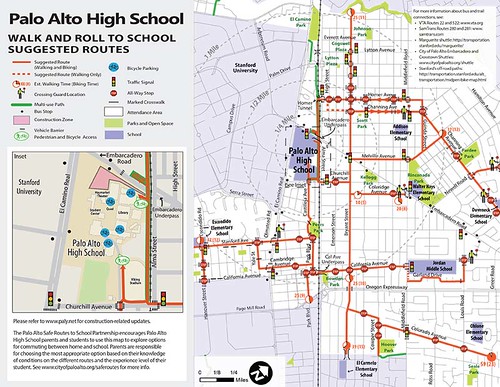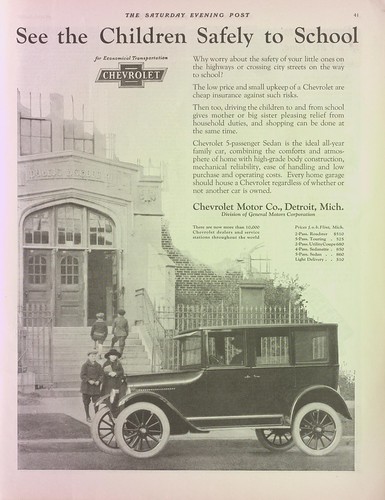Walk/Bike to School Day, Wednesday October 5th
Wednesday is International Walk and Bike to School Day. Note that a separate National Bike to School Day is also held in May, in conjunction with National Bike Month.
-- Walk to School Day and Bike to School Day
-- International Walk to School
-- National Center for Safe Routes to School
 Last month a lot of attention was paid to some app-based approach to getting children to identify hindrances on their routes to school ("The app that gives Oslo's children a direct say over their own road safety," Guardian). It got lots of attention because articles about "apps" and "children" usually do. From the article:
Last month a lot of attention was paid to some app-based approach to getting children to identify hindrances on their routes to school ("The app that gives Oslo's children a direct say over their own road safety," Guardian). It got lots of attention because articles about "apps" and "children" usually do. From the article:With €347,000 (£290,000) in funding from the city, the Research Council of Norway and consultancy Capgemini, Rørholt needed to find ways to create an environment where parents would feel that it was safe enough for children to walk to school. “I was supposed to make a traffic report on all roads in Oslo. That’s a big job,” she comments. “So I thought, why don’t we ask the children how they feel on the street?” The best way to do that, she says, was to turn to gamification. Using a smartphone app, with the idea of users being “secret agents” for the city, children can send immediate reports on their route to school when they come across, for example, a difficult crossing on the street or an area of heavy traffic. Their location is tracked using GPS, so researchers can pinpoint exactly where these hazards are.But what to do for aiding walking (and biking) to school is pretty straightforward, and identifying hindrances can be done many different ways. It should be a priority because it is a "simple" way for children to exercise, and research demonstrates the value of exercise to children's focus in school ("Exercise Before the Bell May Improve Young Children's Focus," Wall Street Journal). From the article:
Researchers found that children spent more time following instructions and working quietly at their desk—so-called on-task behaviors—on days they participated in a school-run physical-activity program before the start of morning classes. On days they didn’t exercise, the children were more likely to interrupt, make noise and stare into space, known as off-task behaviors.=====
Gym classes are traditionally held during school hours but many schools have reduced the time allotted for physical activity in favor of academic subjects, the researchers said. Before-school programs may improve students’ in-class behavior and readiness to learn without taking time away from academics, the study suggested.
Recommendations
1. First, require school systems to do balanced transportation planning, including walking and biking, rather than to focus exclusively on busing.
Mostly school districts focus on busing students to school and walk (and bike) to school programs aren't developed and supported by school systems as a matter of course. Instead they are ad hoc efforts pushed by interested parents. Some programs end up being wildly successful while others fail.
The communities with the best walk (and bike) to school programs provide systemic-structural support for the programs. For example, Minneapolis has a citywide walk to school plan (Minneapolis Safe Routes to School Plan). The school district in Boulder, Colorado includes walk and bike to school planning in its transportation operation at the central administration level. Many of the schools in Boulder have 50% or more children walking or biking to school, which significantly reduces the amount of money needed for bus-based transportation.
In the 1990s, Washington State changed the way it provided money to school systems for transportation, allowing the funds to be spent on sidewalk and other improvements, not just busing.
Palo Alto's walk and bike to school program covers all schools at all grade levels, not just elementary schools which is more typical, and they print and distribute map brochures for each school.

Walk to School Map, Palo Alto High School.
Long term this is a cost reduction measure, by reducing demand for school buses, which cost money to buy, maintain, and fuel, and it is increasingly difficult to find drivers ("Busing issues make for rough start to Ann Arbor school year for some," MLive). According to the US Department of Education, the cost to transport a child to and from school costs about $1.000/year.
2. Site schools in places where walking and biking to school is the best way to get there, remembering that schools are basic building blocks for successful neighborhoods (see the past blog entry, "Rethinking community planning around maintaining neighborhood civic assets and anchors").
Partly this has been a problem because school accreditation processes "require" large campuses and single story schools, which has led to siting schools in areas where to get there, you have to ride a bus.
The National Trust for Historic Preservation has a number of resources on this general topic, because often older historic schools were being shuttered and replaced by those new schools out of town. See the NTHP webpage Community Centered Schools (archived) and the report Helping Johnny Walk to School: Policy Recommendations for Removing Barriers to Community-Centered Schools.
The New York Times had a story, "Gervais, Ore., Schools Go Into Real Estate," about a school district in Oregon that is closing its outlying schools, and refocusing its resources on the in-town schools in walk zones.

The car industry has encouraged driving children to school over walking for more than 90 years. Ad from the Saturday Evening Post, March 3, 1923.
3. Create transportation demand management plans for individual schools, including charter and private schools.
The State of Washington requires that all K-5 schools produce a safe routes to school (walking and biking) map and recommends that each community create a traffic safety and transportation committee to deal with walk to school issues. The state publishes an excellent guide that I highly recommend, School Walk and Bike Routes: A Guide for Planning and Improving Walk and Bike to School Options for Students.
In the UK, schools are required to develop travel plans: see the manual Developing a School Travel Plan and webpage from Sustrans.
* Many charter schools are located in industrial zoned areas because they can find larger buildings there. This creates significant opportunities for problems by mixing industrial, school and other traffic during rush periods. It's especially a problem on 8th Street NE where two or three charter schools are located, the street route to the Metropolitan Branch Trail is there, and a few industrial concerns, and other operations that produce a lot of traffic.
One of the problems of improving transportation management at schools is it can discourage walking to school, by making driving to school more convenient. While I can't find the letter to the editor on the topic by a parent complaining about the time required to drive and escort his child to school, I know that if the writer's child's school implemented a kind of valet service, where the children were just dropped off, the door opened by a volunteer parent attendant, rather than having the parent park and escort the child to school, that the problems of the one hour wait that he experienced would go away.
I know, because I witnessed how this works at Stoneleigh Elementary School in Baltimore County when I worked in the County. Stoneleigh is a national best practice example of walk to school programming. See "Trying To Put Pupils, Parents Back On Feet" from the Baltimore Sun. I joked that the principal basically created a school site TDM program, she had it down to a science, where students of different grades entered the school through different doors, etc., and by doing this she could minimize the time students needed to settle into the school day and was able to maximize instruction time.
It is important to extend such programs to private schools. This tends to not occur systematically, although nationally, here and there, many schools do participate in Walk to School programs, such as Holy Spirit Catholic School in St. Paul, Minnesota, and the State of Washington guidelines do require that "all" elementary schools, not just public schools, create walk to school maps.
4. Ensure that there are "Safe Routes to School."
There are federal and state programs that provide assistance to local communities in focusing resources on exactly that, although many communities don't like to participate in the program, not because they are against improvements, but because of the reporting and other application requirements, which can be burdensome.
The Starkville in Motion advocacy organization in Mississippi is particularly good at focusing community resources on improving the infrastructure for walking and biking to school and should be looked at as a model for how to effect changes.
When schools are sited within neighborhoods, infrastructure improvements for walking and biking benefit everyone, not just children.
Labels: bicycle and pedestrian planning, bicycling, public education/K-12, sustainable transportation, transportation planning, urban design/placemaking, walking





3 Comments:
disclaimer: not a parent.
Another point, I think (in DC) as child bearing years as being in the 30s. millennials seem to be popping them out earlier. My working thesis is they look at people my age and don't want young kids when they are 40.
Certainly, as you've said before, the driving factor is urban life being more attractive is the "Friends/Seinfeld" effect, also also being able to stumble home drunk and not drink-drive.
Once you have kids in the school age, a big attraction of urban life is not having to drive your kids around all the time, which is what parents of kids seem to do all the time.
And walking/biking to school is part of that.
Now in DC if you are living that dream with your kids beyond 3rd grade you are really dumb. Public schools aren't usable , and private ones are too far away.
But the purple dream remains.
I don't claim to have an answer, but aren't the children of relatively well off people somewhat on "automatic"? That they will achieve because of those advantages? Or do the schools as they are wreck them?
wrt that point, I remember the piece a couple years ago in the Post about kids having a hard time in college, even upper middle class white kids, because they had limited experience working hard in school, and especially, writing serious research papers.
(Back in my day, the parents in our suburban school district weren't gunners, but as students we wrote papers etc. On our own initiative, a group of us went to use the Oakland U library -- a few miles from where we lived -- in researching some papers for 12th grade. I don't remember if a teacher suggested it to us or if we did it ourselves.)
we talked about this stuff in threads before, about IB options, your idea of a "magnet" school offering free enrollment to kids from the suburbs too, to increase the quality of the student pool, and drive up expectations. Which of course, I think is a great idea.
The problem of course with all the high schools is that most are too small to benefit from economies of scale that could improve outcomes significantly.
To me, having an IB high school ought to be a major priority in the school system, to drive improvement.
Seattle IB as a way to rebuild a Title I high school:
cf. http://www.seattletimes.com/seattle-news/education/deal-saves-rainier-beach-high-schools-acclaimed-ib-program/
Arlington County:
https://www.washingtonpost.com/local/education/daring-public-school-requires-ap-or-ib-for-all/2013/09/15/4360dc72-1a45-11e3-8685-5021e0c41964_story.html
According to the DCPS website, they have an IB program at all levels.
http://dcps.dc.gov/ib
I see it's operative at Eastern and Banneker. It needs to be operative at a "regular" NW quadrant school and a SE quadrant school EOTR, comparable to the Seattle examples.
I also don't think that Eastern High School seems to be winning from it, at least we're not hearing much about it.
oh, as you can imagine, a number of schools in Upper NW are fine, at least through elementary school (e.g., Lafayette in Chevy Chase, which is practically in Montgomery County).
But I don't know how it is once you move to middle and senior levels. Problematic I'm sure.
AP at Wilson is a tracking mechanism. But past teachers resent the Jay Mathews approach of "encouraging all students to participate in AP for the challenge" because lots of students get put in the classes with no motivation to be there, and they make it very difficult to teach the kids who want to be there, or to help the kids who want to be there but need a lot of help to succeed.
Post a Comment
<< Home